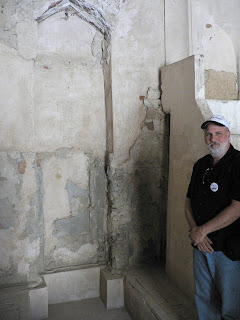More from our 2006 trip:
 |
| Dave Robinson |
Reaching Natanz proper, we parked in a quiet neighborhood at the Jom’e Mosque, a smaller mosque, but one full of interesting examples of Persian calligraphy and tilework, largely intact. Dave Robinson of Pax Christi, a national Roman Catholic peace group, posed next to a niche in one wall of the mosque, taller than himself, which had once been a mihrab (an alcove indicating the direction of Mecca) decorated with fine examples of Islamic decorative art; it is now only bare cinder blocks, the colorful ceramic tiles having been stolen and reinstalled in a gallery in the Victoria and Albert Museum in London.
§ § § § §
After leaving the mosque, we crossed the small courtyard to a pottery shop and atelier, where I bought a small vase. I didn’t notice when I bought it, but it was later pointed out to me that on it, in stylized calligraphy, were words from a poem of Hafez: “My heart tells me that someone like Jesus – with the breath of life – is coming my way.”
§ § § § §
We were expected for lunch at the Allameh Majlesi girls home. This private facility, set up by a kindly mullah is operated for girls or young women who are orphaned, or whose families cannot provide support and guidance for them. The most delicious food of our trip was spread out on a sofreh (a cloth covering the floor, around which guests are seated) – fesenjoon (a stew of goose, ground walnuts, pomegranate syrup, sugar and spice), tahchin (chicken, with crusty, tasty rice), mast o khiar (a seasoned yoghurt and chopped cucumber mixture), sangak bread still warm from the open-hearth oven and the ubiquitous Iranian tea. After dining, a series of challenging and fearless questions from the girls, and gracious hospitality of the cleric, Mr. Ansari, who runs the home, left us all with a warm memory to cherish whenever the name “Natanz” comes up. Robinson, in a report he made to his Pax Christi membership, wrote:
"Noora is seventeen years old. She wants to be an engineer. A victim of parental abuse by her drug addicted parents, Noora lives at Alame Majlesi…She and the other two dozen teenagers that live [there] are like teenagers anywhere. They share the same hopes, fears, dreams and aspirations that all young people have.
"These young women…are anonymous participants in this unfolding fiasco. Few people have ever heard of Alame Majlesi. But everyone has heard of Natanz. In a patch of desert just 10 miles outside town lies the Uranium Enrichment Facility (UEF) that has become the fulcrum point in the standoff with Iran over the future of its nuclear energy program. It is also ground zero in the U.S. plans to wage another preventive war.
"Physicians for Social Responsibility modeled an attack on these facilities, concluding that 2.6 million people would die within the first 48 hours. From the PSR report:
From our map we can see that within 48 hours, fallout would cover much of Iran, most of Afghanistan and spread on into Pakistan and India. Fallout from the use of a burrowing weapon such as the B-61-11 would be worse than from a surface or airburst weapon, due to the extra radioactive dust and debris ejected from the blast site. In the immediate area of the two attacks, our calculations show that within 48 hours, an estimated 2.6 million people would die. About two-thirds of those would die from radiation-related causes, either prompt casualties from the immediate radiation effects of the bomb, or from localized fallout. Over 1,000,000 people would suffer immediate injuries including thermal and flash burns, radiation sickness, broken limbs, lacerations, blindness, crush injuries, burst eardrums and other traumas. In the wider region, over 10.5 million people would be exposed to significant radiation from fallout, leading to radiation sickness, future excess cancer deaths, genetic abnormalities in future generations, as well as high rates of stillbirths, miscarriages, malignancies and hypothyroidism. Most if not all medical facilities near the two attack sites would be destroyed, or located within the radiation ‘hot zone’ and thus unusable. Little or no medical care would be available to the injured in the aftermath of an attack, leading to many avoidable deaths.
Robinson concludes:
"So where does this all leave Noora and the other young women of Alame Majlesi? Their future is a stark question mark. If the U.S. succeeds in gaining international economic sanctions against Iran, they will surely exacerbate the impact on the already weakened Iranian economy, further cutting off job opportunities, perhaps cutting back on Alame Majlesi’s ability to maintain its current services (they were the first such home for abused teenagers in Iran 10 years ago) and probably even strengthen the conservative Iranian regime and precipitate a backlash of ultra-conservatism that will additionally marginalize women in the Islamic state. If the U.S. mounts a military strike on Iranian nuclear facilities, Alame Majlesi and the young women it serves will be vaporized in a millisecond.
"In the last century, 62 million civilians were killed in wars, versus only 43 million military personnel. So it is today in Iraq, with the number of civilian casualties – Iraqis and others -- mounting with each month that goes by. Iran, if that country is subject to nuclear attack, will be worse."


No comments:
Post a Comment